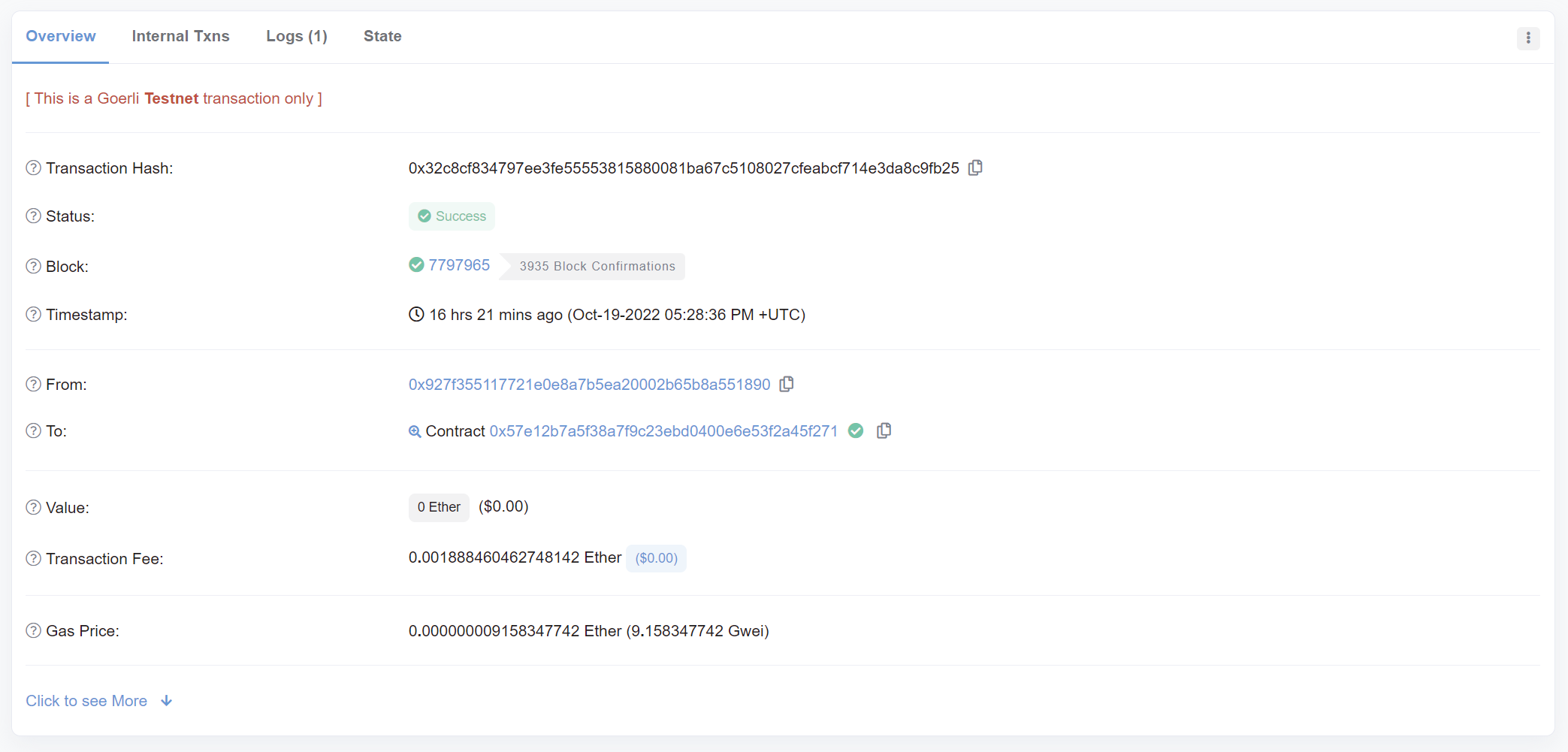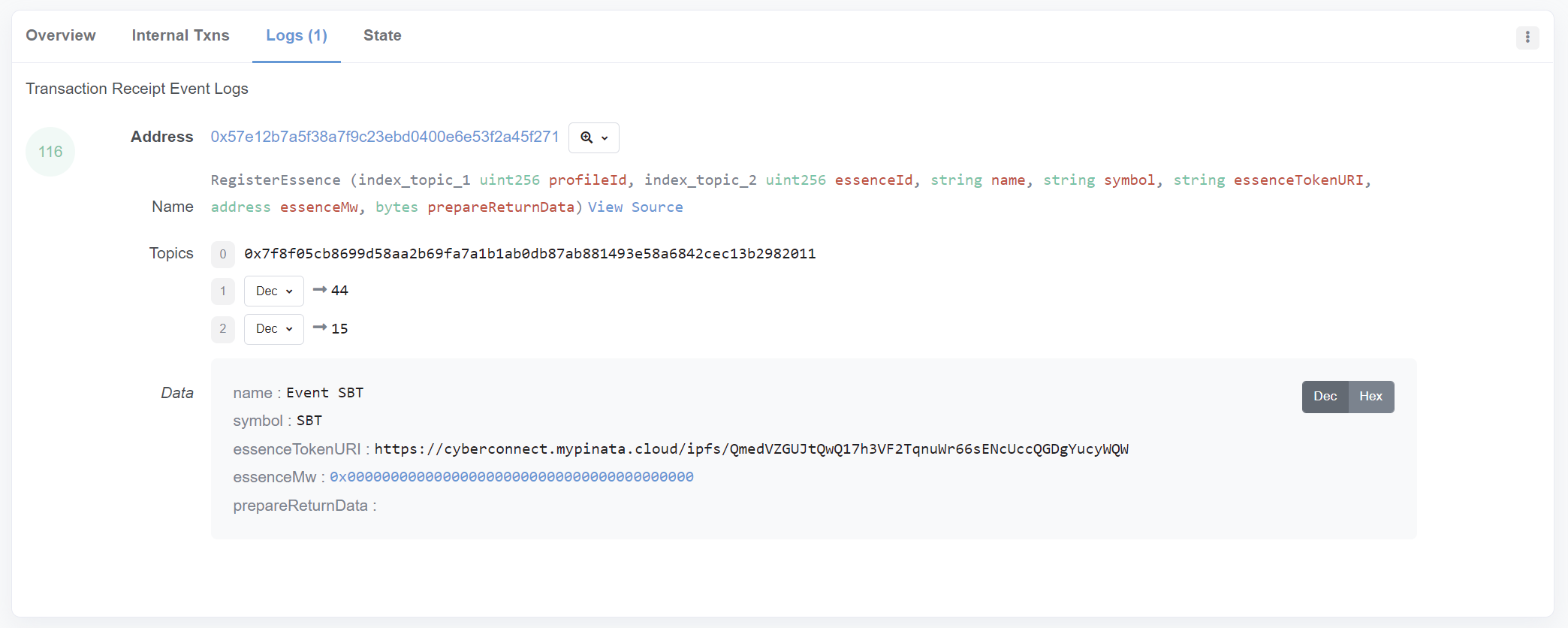Create a Badge
In this section you'll learn how to implement the Register Essence feature. We call essence everything that is content and related to it. Yes, it's also a NFT. It can take the form of a badge, a post, or something completely different that's up to your imagination.
When the user creates an essence, a non-fungible token (NFT) is only being created. The minting and transferring of the NFT is being executed in the collect essence process to the user that collects it, which you'll learn all about in the upcoming section.
We use the terms SBT and NFT interchangeably in this section because a SBT is still a NFT, the only difference being that is non-transferable. In this example the essence will take the form of a badge and will be issued as a SBT. Feel free to change this since these badges can be transferable or non-transferable.
info
The underlying difference between a Non-fungible token (NFT) and a Soulbound token (SBT) is that the SBT is a non-transferable token.
GraphQL mutations
To register an essence, meaning to create a badge for this example, is a two step process and requires two GraphQL mutations: CreateRegisterEssenceTypedData and Relay.
CreateRegisterEssenceTypedDatais used to present data to the user in a readable format:
import { gql } from "@apollo/client";
export const CREATE_REGISTER_ESSENCE_TYPED_DATA = gql`
mutation CreateRegisterEssenceTypedData(
$input: CreateRegisterEssenceTypedDataInput!
) {
createRegisterEssenceTypedData(input: $input) {
typedData {
id
chainID
sender
data
nonce
}
}
}
`;
Relayis responsible for broadcasting the transaction, minting and transferring the NFT:
import { gql } from "@apollo/client";
export const RELAY = gql`
mutation Relay($input: RelayInput!) {
relay(input: $input) {
relayTransaction {
id
txHash
typedData {
id
chainID
sender
data
nonce
}
}
}
}
`;
Metadata Schema
You can think of the Essence Metadata Schema as a standard template used to store data related to content and the NFT holding that data.
You'll notice that some of the fields are following the OpenSea Metadata Standards and this is to ensure that the NFT will be displayed properly on OpenSea and other marketplaces.
Below are all the fields for the Essence Metadata Schema accompanied by a short description on what they represent.
/* Metadata schema for Essence NFT */
interface Media {
/* The MIME type for the media */
media_type: string;
/* The URL link for the media */
media_url: string;
/* Alternative text when media can't be rendered */
alt_tag?: string;
/* The preview image for the media */
preview_image_url?: string;
}
interface Attribute {
/* Field indicating how you would like it to be displayed */
/* optional if the trait_type is string */
display_type?: string;
/* Name of the trait */
trait_type: string;
/* Value of the trait */
value: number | string;
}
export interface IEssenceMetadata {
/* ~~ REQUIRED ~~ */
/* Unique id for the issued item */
metadata_id: string;
/* Version of the metadata schema used for the issued item. */
version: string;
/* ~~ OPTIONAL ~~ */
/* Id of the application under which the items are being minted. */
app_id?: string;
/* Language of the content as a BCP47 language tag. */
lang?: string;
/* Creation time of the item as ISO 8601. */
issue_date?: string;
/* The content associated with the item */
content?: string;
/* Media refers to any image, video, or any other MIME type attached to the content.
Limited to max. 10 media objects. */
media?: Media[];
/* Field indicating the tags associated with the content. Limited to max. 5 tags. */
tags?: string[];
/* ~~ OPENSEA (optional) ~~ */
/* URL to the image of the item. */
image?: string;
/* SVG image data when the image is not passed. Only use this if you're not
including the image parameter. */
image_data?: string;
/* Name of the item. */
name?: string;
/* Description of the item. */
description?: string;
/* URL to a multi-media attachment for the item. */
animation_url?: string;
/* Attributes for the item. */
attributes?: Attribute[];
/* URL to the item on your site. */
external_url?: string;
}
tip
Verify Essence Metadata allows you to verify the validity of an essence's metadata schema.
Create a Badge
To create a badge means to Register a Essence and the process for it does require the following steps:
- Construct the metadata object for the Essence NFT;
- Upload the metadata to IPFS to get the hash;
- Get data in a readable format and the
typedDataIDfor it; - Get the user to sign the message data and get its
signature; - Call the
relayand pass it thetypedDataIDandsignature;
/* Construct the metadata object for the Essence NFT */
const metadata: IEssenceMetadata = {
metadata_id: uuidv4(),
version: "1.0.0",
app_id: "cyberconnect",
lang: "en",
issue_date: new Date().toISOString(),
content: "",
media: [],
tags: [],
image: nftImageURL ? nftImageURL : "",
image_data: !nftImageURL ? svg_data : "",
name: `@${handle}'s event`,
description: `@${handle}'s event on CyberConnect Badge app`,
animation_url: "",
external_url: "",
attributes: [
{
display_type: "string",
trait_type: "title",
value: title,
},
{
display_type: "date",
trait_type: "date",
value: Date.now(),
},
{
display_type: "string",
trait_type: "venue",
value: venue,
},
],
};
/* Upload metadata to IPFS */
const ipfsHash = await pinJSONToIPFS(metadata);
/* Create typed data in a readable format */
const typedDataResult = await createRegisterEssenceTypedData({
variables: {
input: {
options: {
/* The chain id on which the Essence NFT will be minted on */
chainID: chainID,
},
/* The profile id under which the Essence is registered */
profileID: profileID,
/* Name of the Essence */
name: "Event SBT",
/* Symbol of the Essence */
symbol: "SBT",
/* URL for the json object containing data about content and the Essence NFT */
tokenURI: `https://cyberconnect.mypinata.cloud/ipfs/${ipfsHash}`,
/* Middleware that allows users to collect the Essence NFT for free */
middleware: {
collectFree: true,
},
/* Set if the Essence should be transferable or not */
/* SBTs are non-transferable */
transferable: false,
},
},
});
const typedData =
typedDataResult.data?.createRegisterEssenceTypedData?.typedData;
const message = typedData.data;
const typedDataID = typedData.id;
/* Get the signature for the message signed with the wallet */
const fromAddress = await signer.getAddress();
const params = [fromAddress, message];
const method = "eth_signTypedData_v4";
const signature = await signer.provider.send(method, params);
/* Call the relay to broadcast the transaction */
const relayResult = await relay({
variables: {
input: {
typedDataID: typedDataID,
signature: signature,
},
},
});
const txHash = relayResult.data?.relay?.relayTransaction?.txHash;
A couple of things to note:
We used the
attributesfield to store information about the badge (or the event linked to it) and followed the OpenSea Metadata Standards to ensure that it will display properly on marketplaces;We passed as
middlewarethecollectFreemiddleware to will allow users to collect the post for free. We won't dive into middlewares in this guide but you can always check out the Middleware section;We set
transferabletofalseso that the NFT won't be transferable once it ends up in the user's wallet address;
If the registration of the essence (or badge in our case) was successful, you can verify the transaction hash on goerli.etherscan.io.


Note that at this stage you are only registering the SBT. When a user collects a badge is when the SBT actually gets minted and transferred to the user's wallet address, which you'll learn all about in the next section Collect a Badge.